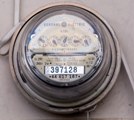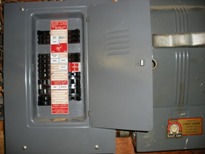
Main Electrical Service Panel
The main electrical panel can also be called the electrical service panel or electrical distribution panel and is where all wiring through out the home connect.
Power lines coming from your local electrical company come in from the pole transformer to a mask on the home or they may come in from underground routing.

When the electrical company’s wires first arrive at your home it first goes to an electrical meter mount, in modern times this is mounted on outside the home on the outside wall, some older homes had this inside. The meter could be an analog (dial type) meter or a digital, perhaps even what they call a smart meter.
The meter mount is a mounting terminal bridging through the meter to the wire that connect to the main cut off inside the home. The purpose of the electrical meter is to measure the amount of power consumption that is utilized in the home for purposes of determining how much your electrical bill will be.
This meter is usually mounted close to where the main electrical wires will enter the home and inside there must be a main electrical cut off located close to this electrical entrance.
Now quite often the main electrical cut-off for the home is part of the main electrical distribution panel, but it can be separated but close by as a separate entity from the panel with the breakers or fuses in it. The purpose of the main cut-off is to shut down electricity beyond which is before the main distribution breaker or fuses, in other words being able to shut off the electricity to all circuits to the entire home.
Most homes that have basements the main cut-off and distribution panel will be located in the basement of the home. There is code rules that require the area around the main cut-off / distribution / electrical panel be clear of clutter, there is also rules relating to minimum distance from water sources. The main electrical cut off in modern homes is in the form of a main cut off breaker will provides not only a shut down switch but over current protection rated at whatever your electrical service is which could be 200 amps.


Older homes had a lever or a rocker switch to shut down power with large cartridge type main fuses. From here the output would go to a fuse or breaker distribution panel.

This is a separate cut off with cartridge type main fuses and a breaker distribution panel.
Common power service to home can be anywhere from 60 amps to 200 amps, 200 amp service seems fairly common in modern homes.
Now the average homeowner is not going to be installing a new main service panel unless the person has above average knowledge meaning you would likely be working in the electrical field. Replacing a main electrical service panel that also includes the main breaker cut off would mean that you would need the utility company to help in order to cut off the power prior (on the utility side of the main breaker cut off) to the main breaker cut off, leave such a major job to a qualified professional electrician.
We will now dissect a modern the electrical service / distribution panel.


Now electrical panels do vary some depending on the manufacturer / type & model.
On the panel to the left there is two large metal bars in the center of the panel, these are the two ungrounded conductor hot buses, you will see metal stubs sticking up from these where breakers will clamp over these. A circuit that uses a breaker that is only contacting one of the hot buses will feed a 110 volt circuit, in the case of a dual pole breaker, the breaker assembly is in contact with both hot buses, and uses two ungrounded conductors (hots) to feed such items as a cooking range or dryer that requires 220 volts. These two ungrounded hot buses are the most dangerous parts to ever accidentally come in contact with when the panel is live. Be sure to read the article called ‘electrical safety’.
Two grounded conductor (neutral) buses can be seen to left and right of the hot buses for the neutral wire of each circuit. Then lastly on the outer sides a bus bar to use for the equipment grounding conductors.
When working with an existing panel (assuming the panel was originally installed by a professional) it should be easy to just look and see the correct bus bar where the grounded conductors (neutrals) [white wires] are connected to, and where all the bare equipment wires are going to, so if adding a new breaker put the wire white (neutral) to the same bus bar where the other white wires are going and the same hold true to where the bare wires are going to. The ungrounded conductors (hots – usually red or black) attach to the breaker itself.
Now there are specialized breaker items such as surge protectors that require a neutral connection or ground coming to it, so make sure you do not follow that as neutrals from circuit cables go to a separate bus bar it should be easy to find.
Bellow is a video I found posted on you tube that does a good explanation of the main electrical panel.
Some comments about the videos.
- I would prefer when working in a live electrical panel to be using better insulated screwdrivers, ones with insulated stems.
- For greater safety – the electrical safety authority is now recommending using only multi meters with fused leads
- Although many have done work in a live main panel carefully without wearing insulated electricians gloves, I would highly recommend using them.
The above two youtube videos I found may be useful as well as many other useful video videos can be found on youtube just do a search there.
We have experts that work in the field on our forums so please take advantage of that for further clarification and questions.
WHILE EXTREME CARE HAS BEEN IMPLEMENTED IN THE PREPARATION OF THIS SELF-HELP DOCUMENT, THE AUTHOR AND/OR PROVIDERS OF THIS DOCUMENT ASSUMES NO RESPONSIBILITY FOR ERRORS OR OMISSIONS, NOR IS ANY LIABILITY ASSUMED FROM THE USE OF THE INFORMATION, CONTAINED IN THIS DOCUMENT, BY THE AUTHOR and / OR PROVIDER.
By: Donald Kerr